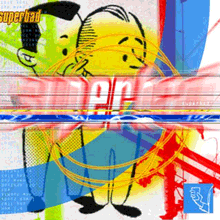 |
| Main Page | |
| News | |
| Search | |
 | |
Net art brings 'geekdom' to the Whitney
| ||||
Experimental hangs with traditional
at
contemporarty New York museum
April 20, 2000
Web posted at: 12:18 a.m. EST (0418 GMT)
|
In this story: Art in its 'embryonic' form Selected Sites Old, new coexist Impressive legacy RELATED STORIES, SITES LESSON PLAN |
(CNN) -- For Maxwell Anderson, director of the Whitney Museum of American Art in New York City, the question isn't why the museum finally decided to feature Internet art in its 2000 Biennial exhibit.
"How could we not?" asks Anderson. "The Whitney for 70 years has followed the instincts of American artists."
| Homework Help | ||
|
| ||
And so, scant years after the World Wide Web started spinning out to corners of the cyber-universe, those instincts have dragged Internet art from the dark corridors of geekdom and into the Whitney's lighted corridors.
The result is Biennial 2000, the museum's latest exhibit featuring the vanguard, or newest developments, of American art.
Every two years, hence the name Biennial, the museum exhibits an extensive display of the artistic creations that represent the latest changes in contemporary art. This Biennial is the first to feature Internet art.
Biennial 2000 runs through June 4 and features 97 artists, including the creators of some innovative Web sites. According to a Whitney news release, those sites are remarkable for using "an entirely new vocabulary of forms and methods, taking advantage of the seemingly random free association of the Internet."
Museum visitors can view the exhibit on five laptop computers.
Art in its 'embryonic' form
"If Net art is in the embryonic stage, it's all the more fascinating," says Anderson. He likens this period to the early part of the 20th century, when artists like Wassily Kandinsky were beginning to experiment with new themes of expression.
Kandinsky, a Russian-born artist, is often considered to be the father of abstract art, art that does not portray objects exactly as they appear in reality.
"You think back to other moments in our history, like the teens and '20s, when found objects became part of the currency of art," he says. "It would be so remarkable to have carefully documented the first stirrings of abstraction in art making under Kandinsky's brush.
"So it's fun to be on the ground floor of understanding what artists will be doing in the years to come," Anderson says.
Lawrence R. Rinder, director of the CCAC Institute at the California College of Arts and Crafts, headed the quest for Internet content in the Biennial, soliciting advice from artists and curators, those in charge of museums, before narrowing the field of exhibits.
"He spent hours and hours sifting through different sites," says Anderson.
Selected Sites
Some of the selected sites include: "Redsmoke" by Lew Baldwin and "Superbad" by Ben Benjamin.
Also, " ® ™ " by the creators of ® ™ ark Web site; "Every Icon" by John F. Simon, Jr.; and "Sampling Broadway" by Annette Weintraub.
The sites range in content, featuring selections as diverse as Weintraub's virtual tour of five spots along Broadway, also known as Manhattan's Great White Way, to Benjamin's mix of graphics and story.
Old, new coexist
Will Net art eventually make old-fashioned, wall-hung art passe? Anderson doesn't see that day coming.
"Everybody thought the newspaper would end the discussions around the hearth, or that radio would end the newspaper, or that TV would end radio," says Anderson. "Everybody always fears this and yet we always make more psychic room for all of these media."
That's one reason why traditional works -- paintings, sculptures, installation art, photography, and cinematic selections -- are featured in the 2000 Biennial, too.
The featured artists include Salomon Huerta ("Untitled Head," oil on canvas), Jennifer Reeder ("Nevermind," video), Chris Verene ("Camera Club," photography), and Rebecca Baron ("okay bye-bye," 16mm film).
Impressive legacy
These latest artists succeed some of the best-known names in American art. The Biennials, which started at the Whitney in 1932, have featured the early works of Georgia O'Keeffe, Jackson Pollock and Jasper Johns, among others.
Such an artistic legacy makes the selection process all the more demanding, Anderson says.
To organize the Biennial, the Whitney relied on six curators from different regions of the country, each bringing a different artistic understanding to the process, Anderson says. He calls their collaborations "a fertile chaos of recommendations from artists and collectors and curators and people who are in the know.
"All six curators were invited to bring in 40 artists' names to start the bidding war, and there was very little overlap," Anderson says. "Ultimately, we had to rationalize this and do a single list."
The list hints at the changes that are sweeping us into the dawn of the new millennium of art, too.
"It's a great time to be an artist," says Anderson, "because a lot of the sacred cows are no longer in evidence."
RELATED SITES
Whitney Museum
Sampling Broadway
Every Icon
What is ® ™ ?
Superbad
Meet Kandinsky
Note: Pages will open in a new browser window
External sites are not endorsed by CNN Interactive.
© 2000 Cable News Network. All Rights Reserved. | Terms under which this service is provided to you. | Read our privacy guidelines.
